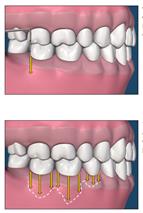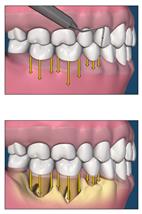Gum Disease
What is gum disease?
Gum disease is also known as periodontal disease or periodontitis. According to the Canadian Dental Association, gum disease is the most common dental problem. 70% of Canadians will develop gum disease in their lifetime and it is the #1 cause of adult tooth loss.
In the beginning, gum disease may be painless and not show any symptoms. But it can get serious very quickly. Preventing gum disease is the best way to fight gum disease. Some of the best prevention tools include brushing twice a day, flossing daily, and regular cleaning appointments and dental check-ups.
Healthy gums are pink and surround the teeth showing no roots. Periodontal disease begins when the gums pull back along with the bone underneath and expose more of the tooth roots. This makes teeth look longer.

In later stages, the gums become red and swollen. This puts more stress on the teeth and causes more tissue and bone loss. The structures supporting the teeth are weakened and teeth may become loose and “wiggly”. If this is not treated, teeth will eventually fall out.

What causes gum disease?
There are many factors that can affect a person’s oral health and lead to gum disease. Gum disease can occur more quickly if a person has diabetes, smokes, takes certain prescription medications, or has other health conditions; however, it is usually caused by bacteria found in dental plaque.
Dental plaque is a clear, sticky material that constantly forms on your teeth. The bacteria in plaque feed on sugar from the foods you eat and drink. They then make chemicals and toxins that irritate your gums. If not completely removed by brushing or flossing, plaque can harden into a substance known as calculus/tartar which irritates gums. When gums are irritated, they get puffy and pull away from your teeth. This leaves spaces (pockets) between them.
How is gum disease measured?
Pockets are measured with a tool called a periodontal probe. It has 1 millimetre markings for easy visualization. We record the depth of each pocket in three areas on each side of the tooth (a total of 6 recordings). By doing this, we can figure out the amount of bone loss around the teeth.
Pocket depths and bone loss readings are important in determining the type of treatment our patients need. Together with X-rays, the dentist will have an accurate record of the periodontal condition of the teeth.


Could I be at risk?
- Do you smoke?
- Do you have diabetes?
- Is your diet low in important nutrients?
- Are you taking any medications such as antidepressants, heart medications, or birth-control pills?
- Do any family members have periodontal disease?
- Do you grind/clench your teeth?
- Are you under a lot of stress?
- Do you have bad breath?
- Are your gums red and swollen or do they bleed when you brush and floss your teeth?
- Are your gums pulling away from your teeth and receding?
- Have you noticed a change in the way your teeth fit together?
- Do you have loose teeth or have you recently lost any teeth?
If you answered yes to any of these questions, you may be at risk for gum disease.











